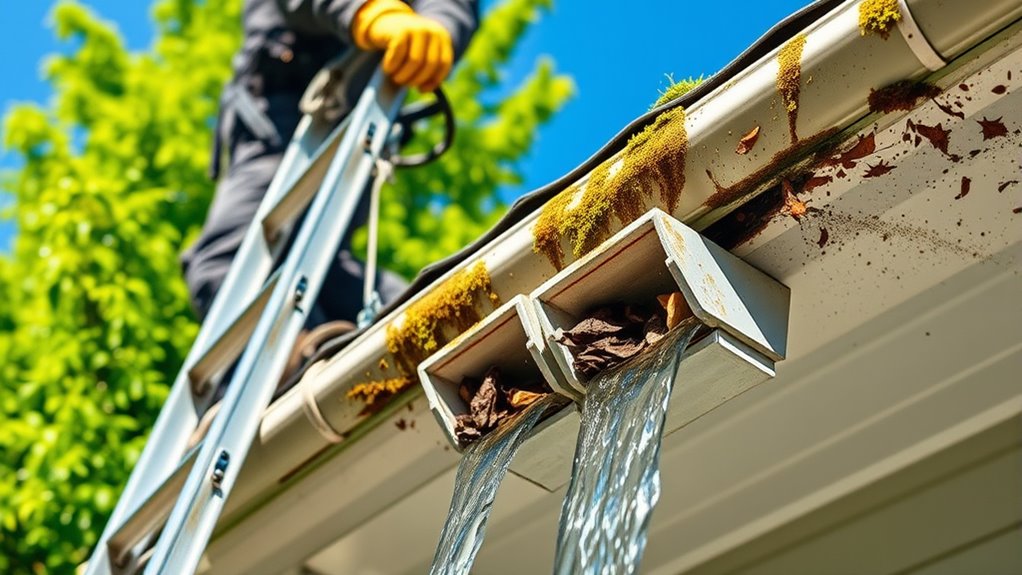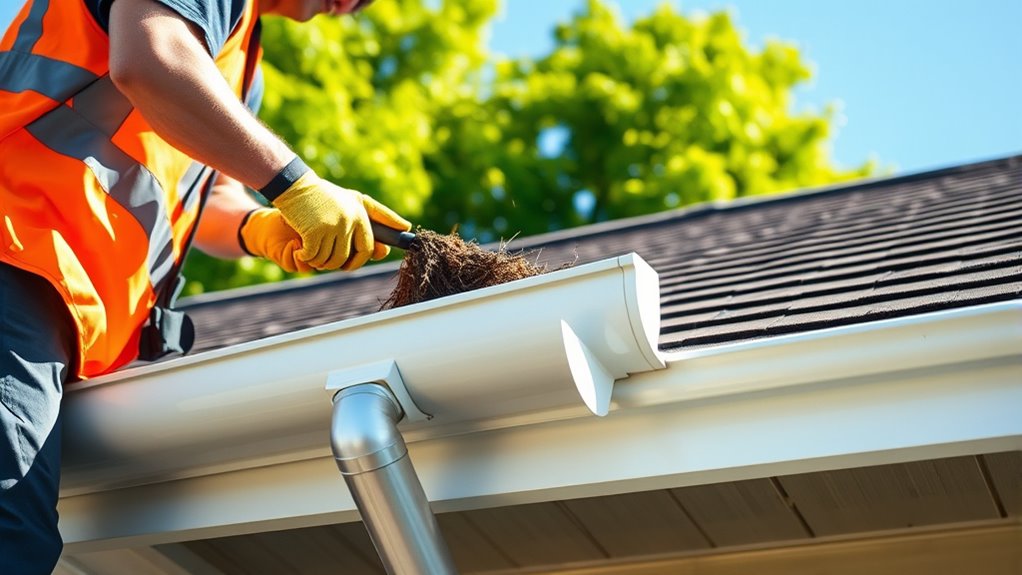To keep your rainwater gutters and downspouts in top shape, regularly clear out leaves and debris to prevent clogs and water overflow. Check for loose fittings, cracks, or rust, and repair any damage promptly to guarantee proper water flow away from your home. Installing guards can reduce debris buildup. Consistent inspections and maintenance help protect your foundation, walls, and basement from water damage. Keep your system in good condition—more tips follow to help you stay ahead.
Key Takeaways
- Regularly clean gutters to remove leaves, dirt, and debris, ensuring free water flow.
- Inspect and repair downspouts for cracks, blockages, or looseness to prevent water damage.
- Check gutters and downspouts for rust, corrosion, or damage, and address issues promptly.
- Install gutter guards or screens to reduce debris buildup and minimize maintenance needs.
- Ensure proper drainage by confirming downspouts direct water away from the foundation.

Have you ever wondered how your home stays protected during heavy rains? It all comes down to the unseen work of your gutters and downspouts. These systems are your first line of defense against water damage, but they require regular maintenance to perform their best. Gutter cleaning is a critical step in this process. Over time, leaves, dirt, and debris accumulate in your gutters, blocking the flow of water. If you neglect this task, water can overflow and cascade down your walls or pool around your foundation, causing damage over time. When you clean your gutters, you remove these obstructions, ensuring water flows freely toward your downspouts. This process might seem simple, but it’s essential for preventing costly repairs later on.
While keeping your gutters clear is crucial, you also need to pay close attention to your downspouts. Downspout repair is often overlooked but is equally important. If your downspouts are cracked, loose, or clogged, water won’t be directed away from your house effectively. Instead, it might spill over the sides or leak through damaged areas, undermining your home’s foundation and encouraging mold growth. Repairing or replacing damaged downspouts ensures water is channeled safely away from your basement and foundation, reducing the risk of flooding or structural issues. Sometimes, a simple patch or a new section of pipe is enough, but in more severe cases, replacing an entire downspout might be necessary.
Proper downspout repair prevents water damage and foundation issues by ensuring effective drainage.
Regular maintenance goes beyond just cleaning and repairing. You should also check for signs of rust or corrosion, especially if your gutters are made of metal. These issues can weaken the structure, leading to leaks or even collapses during storms. Installing guards or screens can help reduce debris buildup, making cleaning easier and less frequent. When inspecting your system, look for any loose brackets or fittings, as these can become a hazard if they fall or cause drainage issues. Addressing small problems promptly prevents them from turning into more significant, costly repairs. Additionally, considering the use of effective drainage solutions can further enhance your system’s performance and longevity.
In the end, maintaining your rainwater gutters and downspouts isn’t just about preserving your home’s appearance; it’s about safeguarding your property from water damage. Regular gutter cleaning and downspout repair keep water flowing efficiently away from your foundation, basement, and walls. By staying proactive, you can avoid the headaches and expenses that come with neglecting this essential part of your home’s drainage system. It’s a simple task that offers big protection, giving you peace of mind during every storm.
Frequently Asked Questions
How Often Should I Replace My Gutters and Downspouts?
You should consider replacing your gutters and downspouts every 20 to 30 years, depending on the gutter material lifespan. If you notice significant rust or downspout corrosion, it’s a sign they need replacing sooner. Regular inspections help spot issues early, especially in areas with harsh weather. Upgrading materials like aluminum or vinyl can extend their lifespan, but timely replacement guarantees your home stays protected from water damage.
What Materials Are Best for Rainwater Gutters?
You should choose gutters made from materials like aluminum, vinyl, or copper for durability and low maintenance. Aluminum gutters come in various gutter color options and are lightweight, making installation easier. Vinyl options are budget-friendly and resistant to rust, available in different colors and style choices. Copper offers a classic look with longevity but is more expensive. Select based on your home’s style, climate, and personal preference to guarantee the best fit.
Can Gutters Be Installed Without Professional Help?
Yes, you can do DIY installation of gutters if you’re comfortable with basic handyman skills. Start by carefully measuring your roof’s gutter sizing to ensure proper fit and drainage. Use the right tools and follow manufacturer instructions closely. Take your time, double-check measurements, and prioritize safety. With patience, proper planning, and attention to detail, you can successfully install gutters on your own, saving money and gaining a sense of accomplishment.
How Do I Prevent Ice Dam Formation in Gutters?
Did you know ice dams can cause over $10 billion in property damages annually? To prevent ice dam formation, focus on gutter insulation and proper ventilation. Guarantee your gutters are clear of debris, and add insulation to reduce heat escaping from your attic. This keeps snow melting evenly and prevents ice buildup. Regularly inspecting and maintaining these elements helps you avoid costly repairs and keeps your home safe during winter.
Are There Eco-Friendly Options for Gutter Maintenance?
Yes, you can choose eco-friendly options for gutter maintenance. Opt for biodegradable gutter cleaning products that break down naturally, reducing environmental impact. Regularly inspect and clean your gutters to improve rainwater harvesting efficiency and prevent clogging. Consider installing leaf guards made from recycled materials to minimize debris buildup and maintenance needs. These sustainable practices help protect your gutters, support rainwater harvesting, and promote eco-conscious home upkeep.
Conclusion
Maintaining your rainwater gutters and downspouts is like giving your home a essential health check-up. When you stay proactive, you prevent clogs and water damage, keeping your house dry and safe. Regular cleaning and inspections are simple steps that save you money and stress down the road. Think of it as watering a plant—you nurture it, and it thrives. Stay diligent, and your gutters will serve you well for years to come.









